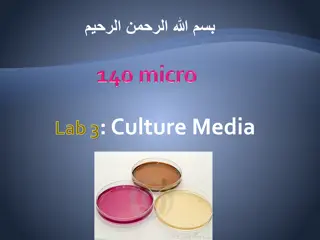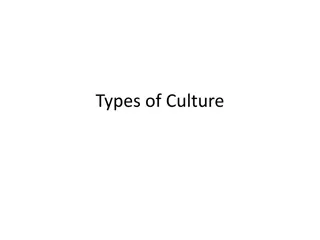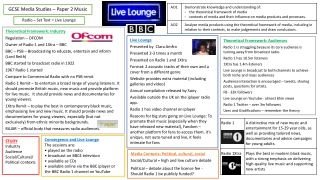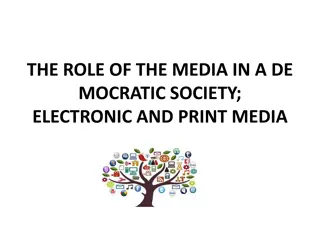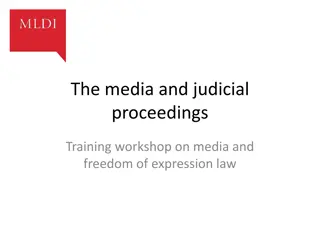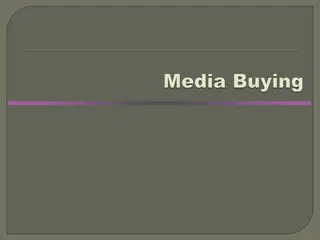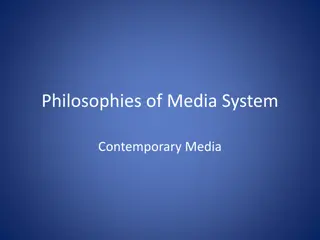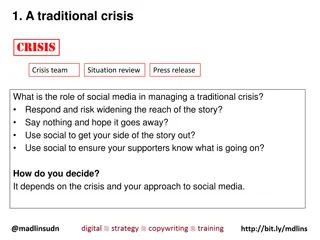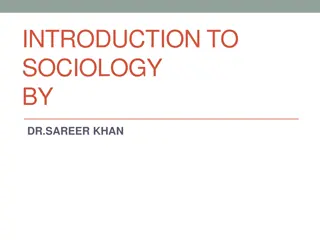Culture Media
Culture media play a crucial role in isolating bacteria from clinical specimens. Water, electrolytes, peptone, agar, meat extract, yeast extract, and blood/serum are essential constituents used in culture media. These components provide nutrients, solidifying agents, and growth factors necessary for the cultivation of bacteria in laboratory settings. By understanding the composition of culture media, scientists can create the ideal environment for bacterial growth and identification.
Download Presentation

Please find below an Image/Link to download the presentation.
The content on the website is provided AS IS for your information and personal use only. It may not be sold, licensed, or shared on other websites without obtaining consent from the author. Download presentation by click this link. If you encounter any issues during the download, it is possible that the publisher has removed the file from their server.
E N D
Presentation Transcript
CULTURE MEDIA Required to isolate the bacteria from the clinical specimens. CONSTITUENTS OF CULTURE MEDIA Constituent 1)Water Explanation Distilled water or potable water with low mineral content. Serves as the source of hydrogen and oxygen. Sodium chloride or other electrolytes. 2)Electrolytes
CONSTITUENTS OF CULTURE MEDIA Peptone: Complex mixture of partially digested proteins. Source- from lean meat or other protein material such as heart muscle, casein or fibrin, or soya flour usually by digestion with proteolytic enzymes such as pepsin. Constituents - proteoses, aminoacids, inorganic salts (phosphates, potassium magnesium) and accessory growth factors like nicotinic acid and riboflavin.
CONSTITUENTS OF CULTURE MEDIA Agar Used for solidifying agent. Agar (agar-agar) is prepared from the cell wall of variety of seaweeds. Components- Long-chain polysaccharide (D-galctopyranose units) and a small amount of protein-like material, long chain fatty acids and traces of inorganic salts (calcium and magnesium). Agar is preferred over gelatine o Bacteriologically inert o Melts at 98 C and usually solidifies at 42 C. o Does not add any nutritive property to the culture medium. o Whereas gelatin is liquefied by a number of bacteria and it melts at 24 C, and remains in liquid state at room temperature.
CONSTITUENTS OF CULTURE MEDIA Agar Concentration of agar used: o Solid agar preparation - 1-2% o Semisolid agar- 0.5% o Solid agar to inhibit Proteus swarming- 6% Preparation of agar media- The appropriate amount of agar powder is added to water and the mixture is dissolved and sterilized by placing it in an autoclave. When the temperature of the molten agar comes down to 450C, it is poured to the petri dishes and then allowed to set for 20 minutes.
CONSTITUENTS OF CULTURE MEDIA Meat extract Highly concentrated meat stock, usually made from beef, contains protein degradation products, inorganic salts, carbohydrates and growth factors. Yeast extract Prepared from washed cells of Baker s yeast. It contains aminoacids, inorganic salts (potassium and phosphates) and carbohydrates. Malt extract- Consists of maltose (about 50%), starch, dextrin, glucose and 5% protein products.
CONSTITUENTS OF CULTURE MEDIA Blood and serum Important components of enriched media and provide extra nutrition to fastidious bacteria. Usually 5-10% of sheep blood is used. Horse, ox or human blood also can be used. Blood should be collected aseptically and rendered non-coagulable by defibrillation (by shaking the blood in a bottle containing sterile glass beads) or adding oxalate or citrate. Serum is sterilized by filtration after collection.
TYPES OF CULTURE MEDIA Based on consistency, culture media are grouped into: Liquid media (or broth) Semisolid media Solid media 2. Based on growth requirements, culture media are classified as- 1. Defined or synthetic media o Simple synthetic media o Complex synthetic media Routine laboratory media-They are prepared from nutrients such as aqueous extract of meat, peptone etc. Simple/ basal media o Enriched media o Enrichment broth o Selective media o Differential media o Transport media o Anaerobic media o
Simple/ basal media Contain minimum ingredients that support the growth of non- fastidious bacteria. o Peptone water-It contains peptone (1%) + NaCl (0.5%) + water o Nutrient broth- It is made up of peptone water + meat extract (1%). o Nutrient agar-It is made up of nutrient broth + 2% agar. o Semisolid medium: It is prepared by reducing the concentration of agar to 0.2 0.5 %.
Uses of basal media o Testing the non-fastidiousness of bacteria o They serve as the base for the preparation of many other media. o Nutrient broth is used for studying the bacterial growth curve o Nutrient agar is the preferred medium for- o Performing the biochemical tests such as oxidase, catalase and slide agglutination test etc. o To study the colony character o Pigment demonstration
Enriched Media Basal medium is added with additional nutrients such as blood, serum or egg. In addition to non-fastidious organisms, they also support the growth of fastidious nutritionally exacting bacteria. Blood agar - o Prepared by adding 5-10% of sheep blood to the molten nutrient agar at 450C. o Tests the hemolytic property of the bacteria, which may be either- i) partial or (green) hemolysis and ii) complete or hemolysis
Enriched Media Chocolate agar Heated blood agar, prepared by adding 5-10% of sheep blood to the molten nutrient agar at 700C More nutritious than blood agar, and even supports certain highly fastidious bacteria such as Haemophilus influenzae that does not grow on blood agar.
Enriched Media Loeffler's serum slope- is used for isolation of Corynebacterium diphtheriae. Blood culture media- Culturing microorganisms from blood specimen. They are either monophasic or biphasic media. o Monophasic medium -brain heart infusion (BHI) broth. o Biphasic medium has a liquid phase containing BHI broth and a solid agar slope made up of BHI agar.
Enrichment broth Liquid media added with some inhibitory agents which selectively allow certain organism to grow and inhibit others. Important for isolation of the pathogens from clinical specimens which also contain normal flora (e.g. stool and sputum specimen). o Tetrathionate broth (used for Salmonella Typhi) o Gram negative broth- for isolation of Shigella o Selenite F broth for isolation of Shigella o Alkaline peptone water (APW)- for Vibrio cholerae
Selective media Solid media containing inhibitory substances that inhibit the normal flora present in the specimen and allow the pathogens to grow. Media Used for isolation of Lowenstein Jensen (LJ) medium Mycobacterium tuberculosis Thiosulphate Citrate Bile salt Sucrose (TCBS) Vibrio species DCA (Deoxycholate Citrate Agar) Salmonella and Shigella from stool XLD (Xylose Lysine Deoxycholate) agar Salmonella and Shigella from stool Potassium tellurite agar (PTA) Corynebacterium diphtheriae Wilson Blair bismuth sulphite medium Salmonella Typhi.
Selective media Lowenstein LJ Media
Transport media Used for the transport of the clinical specimens suspected to contain delicate organism or when the delay is expected while transporting the specimens. Bacteria do not multiply, they only remain viable. Organism Streptococcus Pike s medium Neisseria Vibrio cholerae Transport media Amies medium, Stuart s medium VR (Venkatraman-Ramakrishnan) medium Autoclaved sea water Cary Blair medium Buffered glycerol saline Cary Blair medium Shigella, Salmonella
Differential media Differentiate between two groups of bacteria by using an indicator. Differential media Features 1)MacConkey agar Differential and low selective medium -used for the isolation of enteric GNB. Differentiates organisms into LF (pink colonies, e.g. Escherichia coli) and NLF or (colorless colonies, e.g. Shigella). Composition- Peptone, lactose, agar, neutral red (indicator) and taurocholate
Differential media Differential media Features 2)CLED agar -Cysteine lactose electrolyte- deficient agar Similar to MacConkey agar. Used as an alternative to combination of blood agar and MacConkey agar, for the processing of urine specimens Advantages over MacConkey agar-It is less inhibitory than MacConkey agar, supports the growth of Gram positive bacteria (except hemolytic Streptococcus) and Candida. Advantage over blood agar -It can prevent the swarming of Proteus.
Anaerobic Culture Media Contain reducing substances which take-up oxygen and create lower redox potential and thus permit the growth of obligate anaerobes such as Clostridium. Robertson s cooked meat (RCM) broth o Contains chopped meat particles (beef heart), which provide glutathione (a sulfhydryl group containing reducing substance) and unsaturated fatty acids. o Most widely used anaerobic culture medium. o Also used for maintenance of stock cultures.
Anaerobic Culture Media (cont..) Other anaerobic media include o Thioglycollate broth o Anaerobic blood agar o BHIS agar-Brain heart infusion agar with supplements (vitamin K and hemin) o Neomycin blood agar o Egg yolk agar o Phenyl ethyl agar o Bacteroides bile esculin agar (BBE agar)
Synthetic media Chemically defined media are used for various experimental purposes, prepared exclusively from pure chemical substances and their composition i.e exact quantity of each chemical used is known.
Simple synthetic media Provide the basic essentials for the growth of many non-fastidious heterotrophs but they will not support growth of fastidious bacteria.
Complex synthetic media - In addition to the above, certain aminoacids, purines, pyrimidines, and other growth factors are incorporated. Hence, they can also support the growth of more exacting bacteria.
References Textbook of Medical Microbiology by Ananthnarayan, Paniker Textbook of Medical Microbiology by C.P Baweja Textbook of Medical Microbiology by S. Bhat, A.S.Sastry Textbook of Medical Microbiology by D.R.Arora, Brij bala Arora




